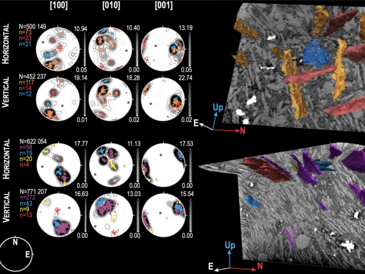Kahl, W.-A., Dilissen, N., Hidas, K., Garrido, C. J., López-Sánchez-Vizcaíno, V. and Román-Alpiste, M. J.
Journal of microscopy (2017) 268, 193-207
https://doi.org/10.1111/jmi.12598
We reconstruct the 3‐D microstructure of centimetre‐sized olivine crystals in rocks from the Almirez ultramafic massif (SE Spain) using combined X‐ray micro computed tomography (‐CT) and electron backscatter diffraction (EBSD). The semidestructive sample treatment involves geographically oriented drill pressing of rocks and preparation of oriented thin sections for EBSD from the ‐CT scanned cores. The ‐CT results show that the mean intercept length (MIL) analyses provide reliable information on the shape preferred orientation (SPO) of texturally different olivine groups. We show that statistical interpretation of crystal preferred orientation (CPO) and SPO of olivine becomes feasible because the highest densities of the distribution of main olivine crystal axes from EBSD are aligned with the three axes of the 3‐D ellipsoid calculated from the MIL analyses from ‐CT. From EBSD data we distinguish multiple CPO groups and by locating the thin sections within the ‐CT volume, we assign SPO to the corresponding olivine crystal aggregates, which confirm the results of statistical comparison. We demonstrate that the limitations of both methods (i.e. no crystal orientation data in ‐CT and no spatial information in EBSD) can be overcome, and the 3‐D orientation of the crystallographic axes of olivines from different orientation groups can be successfully correlated with the crystal shapes of representative olivine grains. Through this approach one can establish the link among geological structures, macrostructure, fabric and 3‐D SPO‐CPO relationship at the hand specimen scale even in complex, coarse‐grained geomaterials.


